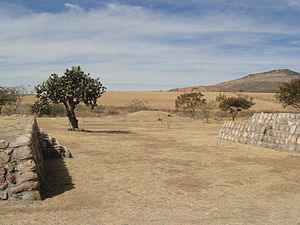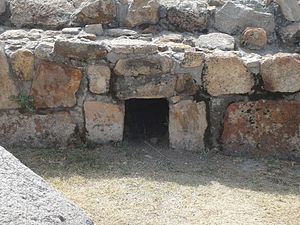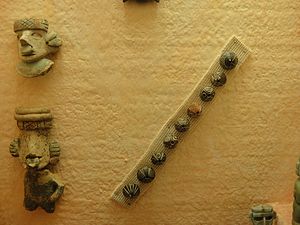Plazuelas
Plazuelas is a prehispanic archaeological site located just north of San Juan el Alto, some 2.7 kilometers (1.57 mi.)
[1] The site is open to the public; it is dominated by a large, rectangular plaza with several pyramidal structures and platforms, along with a massive ball court.
The original settlement was considerably larger, with a large, circular structure called El Cajete marking its eastern extent.
[1] Very little is known about these societies inhabiting the Bajio Region, they are thought to have been members of hunter-gatherer, fishing Chichimec groups, it is now known that these places were trading confluence routes between central Mexico with northern and western Mesoamerica.
[4] In prehispanic times, the Bajio region saw the most human development due to the fertility of the soil and the presence of surface water for agriculture.
Not too long ago, the Bajio Region and a good part of the Mexican central plateau were considered of little archaeological interest.
[9] Data from historical documents indicated that the prehispanic Bajio inhabitants were only Chichimeca, nomadic groups with appropriation economies and belligerents.
[9] During the last ten years, archaeological studies have had a major boost in Guanajuato, and several myths of the Bajio past became truth, have provided better founded explanations based on the prehispanic life in this geographic area.
[9] Three aspects seem fundamental: a) the Bajio as an important part of the Mesoamerican universe was a trade communication region and a link between three the cultural areas proposed by Paul Kirchhoff (1967): Central, North and West Mexico; b) theories based on influences determination from major population centers, has now been replaced by understanding the interactions and bi-directional relationships, where the implications of local societies such as Peralta have barely been addressed but no doubt will continue to investigate; c) during the mesoamerican classical period, between 300 and 700 CE, the Bajio developed a notable agricultural population, with a social and political organization structure, in addition to its deep regional cultural roots, that has been identified as the Bajio tradition.
In modern times only one ethnic group is customarily referred to as Chichimecs, namely the Chichimeca Jonaz, although lately this usage is being changed for simply "Jonáz" or their own name for themselves "Úza".
As the Spaniards worked towards consolidating the rule of New Spain over the Mexican indigenous peoples during the sixteenth and seventeenth centuries, the "Chichimecan tribes" maintained a resistance.
A number of ethnic groups of the region allied against the Spanish, and the following military colonization of northern Mexico has become known as the "Chichimeca Wars".
Many of the peoples called Chichimeca are virtually unknown today; few descriptions mention them and they seem to have been absorbed into mestizo culture or into other indigenous ethnic groups.
Other "Chichimec" peoples maintain a separate identity into the present day, for example the Otomies, Chichimeca Jonaz, Coras, Huicholes, Pames, Yaquis, Mayos, O'odham and the Tepehuánes.
With his descriptions of the rich and different cultures of the various "uncivilized" tribes, the picture of the uniform Chichimec barbarians was changed, although in Mexican Spanish the word "Chichimeca" remains connected to an image of "savagery".
The historian Paul Kirchhoff, in his work "The Hunting-Gathering People of North Mexico," described the Chichimecas as sharing a hunter-gatherer culture, based on the gathering of mesquite, agave, and tunas (the fruit of the nopal).
The structure complex known as Casas Tapadas comprises four buildings, a palace and a small altar bordered by a thick wall with a seating bench on the inside.
[1] Casas Tapadas and the ballgame court to the south are connected by a 220-meter (720 ft.) long road [1] The building decoration depicts the stylized motif of “atadura de años” (bundle of years), the design was modified in several occasions to commemorate the end of a life cycle.
[1] The complex has a perimeter wall with a large walkway built into the interior facade, interrupted by seven entrances: three to the north, three to the south and one to the west.
Inside are traces of a wall that possibly divided the space, covered with a clay floor, probably remains of two small patios.
[1] The ballgame court is I-shaped, measuring some 65 by 31 meters (213 by 101 ft.) [1] It presumably had a religious sense, it is believed that the game purpose was to assure the victorious rising of the sun every morning, with renewed energy to provide life on earth.
[1] The marker found at the eastern side of the court, depicts attributes of the ancient rain gods, reiterating their association with fertility.
This is expressed by the feather headdress, eye circles, the spiral depicting a mouth, the coiled nose, gums with teeth and the lower jaw.
[3] The model outline Bajio architectonic elements, such as sunken patios and other features from gar away regions, such as Teuchitlán (Guachimontones), that confirms the multi-ethnicity hypothesis of these lands.






















